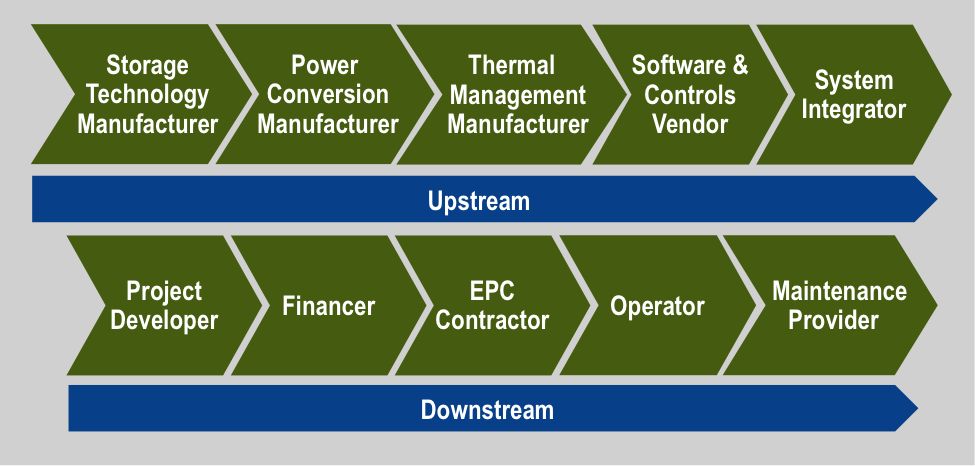This guest post is provided by Navigant Research.

For those in the know, energy storage price points have been a big topic of discussion. As more batteries energy storage systems (BESSs) are installed and continue to operate, concerns about whether batteries can safely and reliably perform in grid-connected energy storage applications are eliminated. But, while it is true that BESS costs continue to come down, this is just one piece of the energy storage market development puzzle.
The Rise of the BESS Value Chain
Navigant Research sees the maturation of battery energy storage delivery chains as another key driver in the growth of energy storage system (ESS) markets. While these projects differ by application (such as a grid-scale installation or a distributed behind-the-meter system at a utility customer’s property), four key components must come together to deliver the benefits of energy storage. These four components are shown in the figure below, and include battery energy storage technology, power conversion equipment, software and controls, and system integration services.
Energy Storage Value Chain

Battery Energy Storage Technology
Battery energy storage technology, which includes an anode, cathode, electrolyte, packs, racks, and other components that safely store and release energy, are a critical component of an ESS. However, equally important to a financially viable project are the remaining three ESS value stream components discussed below.
Power Conversion Equipment
A power conditioning system (PCS) is required not only to transform the direct current (DC) battery output into alternating current (AC) power for use on the electric grid by utility customers, but also to adjust characteristics like voltage and power quality. The primary PCS device is a bidirectional inverter, which enables grid integration by supporting AC/DC conversion and the two-way power flow for charge and discharge.
Software and Controls
Software and controls have been developed not only to manage the battery and the PCS, but also to interact with the grid and one or more power market signals. These software and control packages manage battery technology system health while also communicating signals across hardware components and storage technologies within the ESS and the grid system or customer load.
System Integration Services
Systems integrators serve a key role in the ESS value chain by bringing together all necessary equipment, engineering, procurement, permitting, interconnection, and construction services to ensure the system is properly built and operated.
Aligning Regulatory Drivers and Market Signals with New Business Models
Addressing only the technical BESS value chain issues described herein is not enough to solve the market development puzzle. Navigant Research sees two other key issues underpinning the development of financially viable projects in ESS markets. First, states and grid operators need to continue to create power market rules and regulations that drive revenue models, enabling ESSs to deliver their unique benefits. Second, as these regulatory factors and revenue models develop, project developers, asset owners, and financiers need to leverage them in a way that creates new business models that result in bankable ESS projects. One new business model garnering a great deal of attention showcases the unique advantage that BESSs have: the ability to provide ESSs for more than one power market or customer application. Using this so-called revenue stacking approach, a single energy storage asset can monetize multiple revenue streams to deliver value and improve the return on investment for the asset owner.
One such signature BESS project is the focus of Navigant Research’s upcoming webinar on December 15. S&C Electric and LG Chem have partnered with an Ohio municipal power provider on a project that will sell into PJM's frequency regulation market to improve grid reliability, integrate a 4.2 MW solar system into the municipality’s service area, improve local power quality, and reduce peak demand to help the municipality avoid costly PJM peak electricity pricing spikes.
Navigant Research firmly believes that this is exactly the type of project that will drive the rise of ESS markets by enabling innovative project finance equity and debt participation by those who are increasingly anxious to invest in grid-connected energy storage assets.